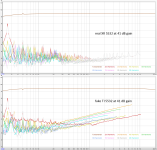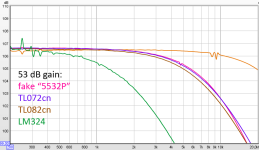These are not exactly 'FAKE' but factory rejects. I have many of them (tl072, tl074, 5532, 4558 etc). The physical difference between original & counterfeit is very apparent.
TI has two type of 5532, 'P' & 'AP'. At least at rs components. I think AP stands for lowest noise one.Old texas instruments made in Portugal were ne5534P...A was used by Signetics in NE5534AN to designate the lower noise.TI wasn't known to make a classification based on noise.
I paid 0.86 USD aYou should ask that question to fakers. These opamp costs next to nothing. You can buy 10-12 unit for $1USD. I hve exactly same type somewhere. But 5532p from post one looks good to me although not sure.
piece.
The customer is always right. If the customer wants a "P", you must deliver a "P", even if an "AP" is better.why would anyone print NE5532P rather than NE5532AP on a fake IC?
Anyway it is just a few seconds re-entering codes in the stamping machine.
not for my knowledgeJust curious, any other Op Amp uses antiparallel cross-input diodes?
No need to, you can use software scope.Sadly I don't own an oscilloscope .
Read all about it in:
https://www.thegearpage.net/board/index.php?threads/scope-died-anyone-use-the-pc-based-ones.1620645/

Suggestion: to read 20V peak (so as to cover what any Op Amp can put out) use a 47k/470 ohm attenuator.
For safety solder 2 antiparallel diodes across the 470 ohm one.

Some use high speed ones think 1N4148, 1N914, etc.; I used humble 1N4002 and they work fine.
I just received 5 TI NE5532P from a local small but supposedly reliable source, but I thought the markings were a little suspicious and then found this thread. The TI logo looked a but strange and the 'ne5532p' characters were not quite in line - although it is difficult to find reliable photos of these nowadays in order to check whether this is normal.
So I checked across pins 2-3 and 5-6 with the diode test using two different DMM's. Some 5532's registered nothing across these pins, and others registered around 1600-1700 millivolts but then nothing after a couple of tests as if the IC was damaged from the application of the voltage. Anti static precautions were observed, so all I can presume is that they were rejects or re-marked opamps that were overly sensitive.
What a pain, because I don't particularly want to accuse the vendor of selling fakes (even though they might not know) for a few dollars of parts. I expect they won't just accept it without argument...we shall see. I'm certainly not worried about the money, but they have to be told.
I'm going to buy a few 5532's from a (supposedly) reliable brick and mortar store tomorrow and see how they test, for interest's sake. However, I'll stick to Mouser from now on (I do get the more expensive parts from them). I WAS trying to support local businesses where I could, but it's too much hassle to risk getting fakes and then deal with it.
Dodgy $$##%%^&** industry!
So I checked across pins 2-3 and 5-6 with the diode test using two different DMM's. Some 5532's registered nothing across these pins, and others registered around 1600-1700 millivolts but then nothing after a couple of tests as if the IC was damaged from the application of the voltage. Anti static precautions were observed, so all I can presume is that they were rejects or re-marked opamps that were overly sensitive.
What a pain, because I don't particularly want to accuse the vendor of selling fakes (even though they might not know) for a few dollars of parts. I expect they won't just accept it without argument...we shall see. I'm certainly not worried about the money, but they have to be told.
I'm going to buy a few 5532's from a (supposedly) reliable brick and mortar store tomorrow and see how they test, for interest's sake. However, I'll stick to Mouser from now on (I do get the more expensive parts from them). I WAS trying to support local businesses where I could, but it's too much hassle to risk getting fakes and then deal with it.
Dodgy $$##%%^&** industry!
Last edited:
Adding to the above...I Googled the date code/batch marking on all five 5532's (21BWQXY) as I suspected that fakers would probably use the same markings on a large run, and I found quite a few hits where 5532's are used on low cost Chinese PCB's all showing this code, and a picture from an Indonesian vendor selling them, with a picture of about 100 all with this code. Hmm. While it could be legit, with the test above I'm fairly sure they're dodgy.
FWIW I think that's a November 2021 date code.
FWIW I think that's a November 2021 date code.
There is nothing suspicious having 100 with the same datecode. Such a chip is maybe a few mm² and you can make thousands of them on a single wafer. So if I bought a roll (smd version) I would expect nothing less than them having all the same datecode. Unless I bought from a broker that put several incomplete rolls in a new full roll.
There isn't a single check that will tell you if it is a fake or not. The only sure thing is decapping and putting it under the microscope. Even if you run the full tests and compare to the datasheet you don't know. And if it complied with all specs, would it matter?
Also don't think that all chinese suppliers sell fakes. Almost all production takes place there. So if they make a production and after production that have a half roll over, it goes to brokers and dealers. Far better to start the next time with a fresh roll so you have less machine time lost. There is a large market for non-complete rolls of components.
There isn't a single check that will tell you if it is a fake or not. The only sure thing is decapping and putting it under the microscope. Even if you run the full tests and compare to the datasheet you don't know. And if it complied with all specs, would it matter?
Also don't think that all chinese suppliers sell fakes. Almost all production takes place there. So if they make a production and after production that have a half roll over, it goes to brokers and dealers. Far better to start the next time with a fresh roll so you have less machine time lost. There is a large market for non-complete rolls of components.
I bought the same amp module shown in message #15 some time ago.
I checked the op-amps ("NE5532P") for protection diodes on the inputs - none there.
so I suspected these are cheap 358s, that may be used for someting else and I checked them and found out:
this is a very rough breadboard test for gain/bandwidth and distortion, compared to a real XR 5532P:


disregard the noise and mains hum in the XR 5532 distorsion measurement!
gain-bandwidth product seems to be around 3-4 MHz, maybe these are some kind of rejected scrap, relabeled?
distortion is quite bad...
anyone any idea what those opamps could be?
I checked the op-amps ("NE5532P") for protection diodes on the inputs - none there.
so I suspected these are cheap 358s, that may be used for someting else and I checked them and found out:
- they are NOT 358s - they can sink quite a lot of current (~ 50 mA shorted)
- they have a phase reversal latchup effect with input below 1 V above negative supply (similar to TL072/082??), when used as source followers.
- they can output 0,8 V below positive supply into a 56 kOhm load.
- they can drive a headphone with single supply voltage down to 2,5 V (somewhat distorted, however!).
this is a very rough breadboard test for gain/bandwidth and distortion, compared to a real XR 5532P:


disregard the noise and mains hum in the XR 5532 distorsion measurement!
gain-bandwidth product seems to be around 3-4 MHz, maybe these are some kind of rejected scrap, relabeled?
distortion is quite bad...
anyone any idea what those opamps could be?
There is nothing suspicious having 100 with the same datecode. Such a chip is maybe a few mm² and you can make thousands of them on a single wafer. So if I bought a roll (smd version) I would expect nothing less than them having all the same datecode. Unless I bought from a broker that put several incomplete rolls in a new full roll.
There isn't a single check that will tell you if it is a fake or not. The only sure thing is decapping and putting it under the microscope. Even if you run the full tests and compare to the datasheet you don't know. And if it complied with all specs, would it matter?
Also don't think that all chinese suppliers sell fakes. Almost all production takes place there. So if they make a production and after production that have a half roll over, it goes to brokers and dealers. Far better to start the next time with a fresh roll so you have less machine time lost. There is a large market for non-complete rolls of components.
Gee, this reply is rather frustrating, showing you didn't read what was written. I didn't comment on getting a number of these myself with the same code, as that would be obviously expected even with through hole parts. I simply commented that the same code is easily found on many listings across the internet. In fact, there are quite a few on eBay with that same code right now. So, if these WERE fake, it would make sense, as the producers are probably not going to go to the trouble of tooling to change codes.
And clearly I know not all Chinese produced semiconductors are fakes and that almost all production takes place there. Do you really think that anyone frequenting this forum doesn't know that?
Of course thousands of them would be made with the same code. I don't expect each IC to have a unique code! But it does seem very unusual to me that this code would show up in so many pictures - and to add to the above - I went to the bricks and mortar store I mentioned above, bought a 5532, and got the very same batch number, which also tested the same with the diode test. I was surprised, as this is one of the two most well known and respected store based suppliers in Australia. I'm assuming my first supplier may have been supplied by this one, which is also a wholesaler. Edit: I also realised they are supposed to stock only the NE5532AP version, which they did not supply.
Are you saying that 'failing' the diode test does not indicate these are not 5532's? That's the only test I referred to. It seems pretty foolproof to me to at least show it's not a 5532 (regardless of what it actually is) but if I'm wrong I'd like to be put right.
And yeah it DOES matter to me that I am getting what I paid for. I bought them for a phono stage in which the designer specifies this opamp for particular reasons.
Last edited:
Good.
One way to test them, and the one that actually matters, is to test the Phono stage that you built around them.
If it performs as expected, so be it.
And if not, now you know why.
One way to test them, and the one that actually matters, is to test the Phono stage that you built around them.
If it performs as expected, so be it.
And if not, now you know why.
follow up to #32:
just out of curiosity I also tested TL072cn and TL082cn to confirm the gain-bandwidth product, compared to the counterfeit 5532.
and, just for fun a LM324:
edit: the orange response is the real XR5532!

the counterfeit is still not a TL072/82, the distorsion is much worse - and once more some LM324 measurements out of curiosity:

so I'll just use them for eventual experiments or cruel torturing, if needed!
edit2: again, disregard the noise and mains hum, it was a very sloppy breadboard circuit with huge gain. power supply was a single 9 V battery with a virtual ground via voltage follower, using the second op-amp.
just out of curiosity I also tested TL072cn and TL082cn to confirm the gain-bandwidth product, compared to the counterfeit 5532.
and, just for fun a LM324:
edit: the orange response is the real XR5532!

the counterfeit is still not a TL072/82, the distorsion is much worse - and once more some LM324 measurements out of curiosity:

so I'll just use them for eventual experiments or cruel torturing, if needed!
edit2: again, disregard the noise and mains hum, it was a very sloppy breadboard circuit with huge gain. power supply was a single 9 V battery with a virtual ground via voltage follower, using the second op-amp.
Last edited:
- Home
- Amplifiers
- Chip Amps
- Fake op amp or not
